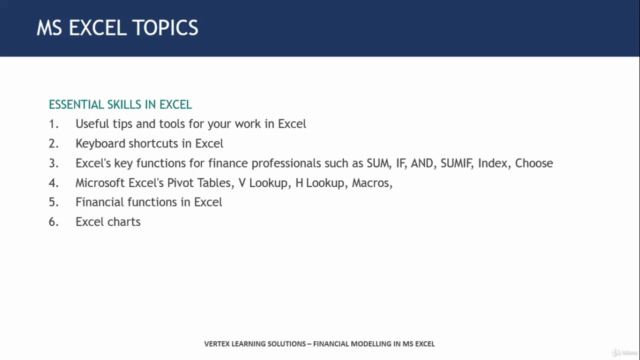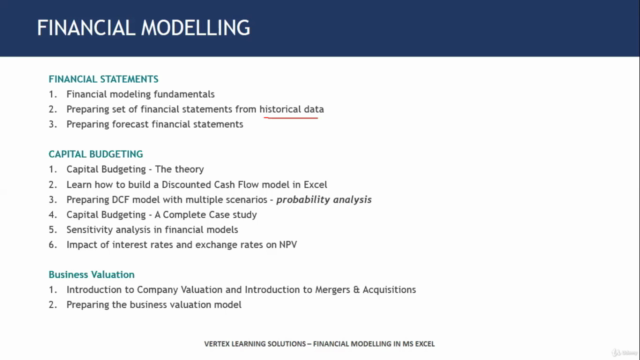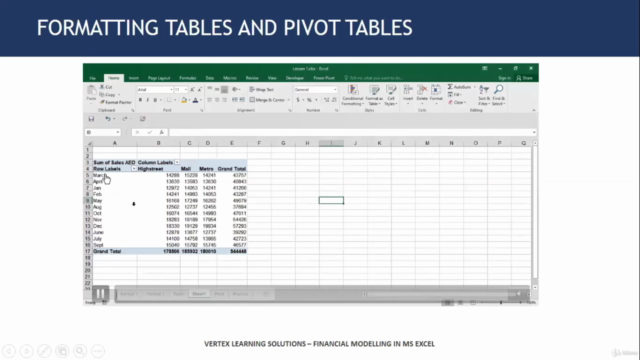Title
Financial Modelling in MS Excel
Prepare How to Prepare Financial Models in MS Excel - Beginners to Advanced

What you will learn
This course is designed for accounting and finance professionals who are keen to learn Financial Modelling in MS Excel.
Learn advanced excel techniques needed by accounting and finance professionals.
Learn how to automate your profit and loss statement
Learn how to automate statement of financial position
Prepare Discounted Cash Flow Models (DCF) using MS Excel
Learn to calculate the project NPV or IRR using financial models.
Business Valuation and Finacial Models
Learn to prepare the forecast profit and loss, forecast statement of financial position and forecast cash flow
Case stidies on prepraing financial models for Profit and Loss Account, Balance Sheet and DCF
Why take this course?
🌟 Financial Modeling in MS Excel: Master the Art from Beginner to Advanced 🚀
OVERVIEW 📈
WHAT YOU WILL LEARN 🎓
- Excel Mastery: Dive into many of MS Excel's advanced features.
- Professional Recognition: Elevate your status as a proficient user within your team.
- Efficiency Boost: Perform regular tasks faster and more efficiently than ever before.
- Financial Statement Creation: Build accurate Profit and Loss, Statement of Financial Position, and Cash Flow statements.
- Valuation Models: Develop profitability models from the ground up.
- Net Present Value (NPV) Modeling: Construct an NPV model independently.
- Data Visualization: Create neat and professional charts and graphs that convey your data effectively.
DETAILED CONTENT 📚
- Introduction to Excel: Lay the foundation for your financial modeling journey with a solid grasp of Excel basics.
- Excel Tips & Tools: Learn useful shortcuts and tools that will enhance your workflow.
- Keyboard Shortcuts: Become more efficient with powerful keyboard shortcuts in Excel.
- Key Functions & Functionalities: Simplify complex tasks with an understanding of Excel's key functions and features made easy.
- SUMIFS Exercise: Put your skills to practice with an exercise on dynamic ranging.
- Financial Functions in Excel: Specialize in financial computations within Excel.
- Pivot Tables: Harness the power of data aggregation and analysis using Pivot Tables.
- Complete P&L Case Study: Build a comprehensive Profit and Loss statement with our step-by-step guide.
- Introduction to Excel Charts: Learn the fundamentals of creating compelling charts.
- Professional Charts Continued: Enhance your case study by adding great-looking professional charts.
- Financial Modeling Fundamentals: Understand the core concepts that underpin financial modeling.
- Company Valuation & M&A Introduction: Get familiar with valuing companies and understanding mergers and acquisitions.
- Build a DCF Model: Learn the intricacies of constructing a Discounted Cash Flow model in Excel.
- Business Valuation Practical: Engage in a full practical exercise on business valuation.
- Capital Budgeting Theory: Grasp the principles behind capital budgeting decisions.
- Complete Capital Budgeting Case Study: Apply your knowledge to a real-world case study.
- Interest Rates & Exchange Rates Impact on NPV: Understand how external factors influence NPV calculations.
- Sensitivity Analysis in Capital Budgeting: Learn to assess the risk and potential returns of capital projects through sensitivity analysis.
PREREQUISITES 📝
- Basic MS Excel Knowledge: Participants are expected to have a good understanding of MS Excel, ideally as an user for more than one year.
- Financial Accounting Familiarity: A grasp of the basics in financial accounting is beneficial for this course.
- Microsoft Office 2013 or Later: Ensure you have the latest version of Microsoft Office installed on your computer to fully utilize the course material and exercises.
ENROLL NOW AND TAKE THE FIRST STEP TOWARDS FINANCIAL EXCELLENCE! 💼✨
Embark on a journey to become an expert in financial modeling with our expert instructor, Syed Muhammad Ali Shah. Whether you're looking to enhance your career opportunities or simply master the skill of financial modeling within Excel, this course is your gateway to success. 🚀📊
Screenshots




Our review
🌟 Course Review: Financial Modeling Masterclass 🌟 GroupLayout rating: 4.35/5
Overall Summary: The "Financial Modeling Masterclass" has received overwhelmingly positive feedback from recent learners, with an impressive global course rating of 4.35 out of 5 stars. The consensus amongst the reviewers is that this course stands out due to its comprehensive and clear approach to teaching financial modeling, as highlighted by Syed Muhammad Ali, the instructor. Learners have appreciated the in-depth explanations provided, which cater to both beginners and those seeking to deepen their understanding of financial models.
Pros:
- Comprehensive Coverage: The course seems to cover a wide range of topics within financial modeling, ensuring that students receive a well-rounded education on the subject.
- Clear Explanations: Reviewers have commended Syed Muhammad Ali for his ability to explain basic modeling concepts in a clear and understandable manner, which is essential for the learning process.
- Instructor's Knowledge: Syed Muhammad Ali has been praised for his extensive knowledge in the field, making him an effective educator who can guide learners through complex subjects.
- Suited for Different Levels: The course content appears to be tailored for individuals at different levels of expertise, from beginners to those looking to refine their skills.
- Real World Application: Some reviewers have pointed out that the course includes concepts often missed elsewhere, which could provide a competitive edge in real-world applications.
- High Relevance and Practicality: Learners have reported that the teachings from this course have been immediately applicable to their work, demonstrating its practical value.
Cons: Despite the high ratings, there are a couple of areas for improvement:
- Advanced Content Requirement: A few learners suggested that while the course is great for beginners, it may need more advanced content for those looking to become more sophisticated in their financial modeling skills.
- Variety of Teaching Methods: While the teachings are clear and effective, some learners might appreciate a wider variety of teaching methods or interactive elements to enhance the learning experience.
Learner Feedback Highlights:
- "Best course i bought from Udemy so far": This statement speaks volumes about the course's quality. It indicates that the course is meeting and exceeding learners' expectations compared to other financial modeling courses available on the platform.
- "Right from the basics which is good for beginners": This emphasizes the course's suitability for individuals who are new to financial modeling and highlights its structured approach to learning.
- "I learned so much from this Financial Modelling course": This demonstrates the impact of the course on the learners' knowledge and skills, suggesting that it delivers on its promises of providing valuable insights into financial modeling.
- "Wished I had taken his course earlier": This expresses a wish for retrospective enrollment, indicating not only satisfaction with the course content but also the perceived importance and utility of the course material in professional settings.
In conclusion, the "Financial Modeling Masterclass" is highly recommended based on recent reviews, which uniformly laud its practical approach to teaching, depth of content, and the instructor's expertise. It stands as a top choice for anyone looking to learn financial modeling or enhance their existing knowledge in this domain.
Charts
Price

Rating

Enrollment distribution
